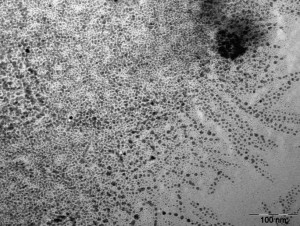 Dr. Aydogan Ozcan demonstrated to us LUCAS imaging technology, which utilizes a mobile phone equipped with a lensfree imaging tool. Then, holographic “shadowlike” images of the patient’s blood can be sent from the phone, or uploaded to a computer, to specialists for analysis, who can then text back results. This can provide for portable and inexpensive blood analysis which can open doors to health care for many people in developing countries who have no access to basic medical care yet. In an age of exponentially increasing globalization, it seems only natural that health care will also become increasingly mobile, so that doctors across the world will be connected and that specialists will able to analyze patients from other countries to increase efficiency and accuracy.
Dr. Aydogan Ozcan demonstrated to us LUCAS imaging technology, which utilizes a mobile phone equipped with a lensfree imaging tool. Then, holographic “shadowlike” images of the patient’s blood can be sent from the phone, or uploaded to a computer, to specialists for analysis, who can then text back results. This can provide for portable and inexpensive blood analysis which can open doors to health care for many people in developing countries who have no access to basic medical care yet. In an age of exponentially increasing globalization, it seems only natural that health care will also become increasingly mobile, so that doctors across the world will be connected and that specialists will able to analyze patients from other countries to increase efficiency and accuracy.
Though advancements in technology, such as nanotechnology, can bring inspiration and answers to problems, new technologies can also can also create new concerns. In the lecture given on toxicology, it was mentioned how these nanoparticles, for example nanosilver, can easily penetrate the skin and travel throughout the body, reaching the brain very quickly. Who knows how they could affect its complex processes?

It scares me that the policy in the United States is that these particles are “innocent until proven guilty”-it seems like it could lead problems in the future. It’s like when people started building nuclear weapons without considering the after affects and how we would dispose of them or use them in the future.
The discussion about how nanosilver could get into our water and interfere with the filtering process by killing the bacteria that are intentionally being used to purify the water was also troublesome, and what if we drink those particles in our water? On a related note, I just saw in yahoo news about how tap water and bottled water have different regulations, and how consumers don’t really know what is in their bottled water. There’s just many things scientists and consumers must take in to consideration for preservation of personal, public, and environmental health.
I enjoyed Leonard H. Rome’s, Dean of UCLA’s medical school, lecture on nanomedicine. I had never heard of vaults before. They are hollow capsules inside cells, composed of 3 proteins and a small RNA, and their function inside cells is unknown, but we can create them and use them as drug capsules.
![]()
http://www.intomobile.com/2008/12/28/lucas-imaging-technology-turns-cellphone-into-blood-analysis-tool.html
http://www.readwriteweb.com/archives/mobile_phones_to_serve_as_doctors_in_developing_countries.php
http://news.yahoo.com/s/ap/ap_on_bi_ge/us_bottled_water_vs_tap
http://www.ingentaconnect.com/content/asp/jnn/2009/00000009/00000008/art00066
http://www.popsci.com/scitech/article/2004-07/nano-pollution-no-tiny-issue